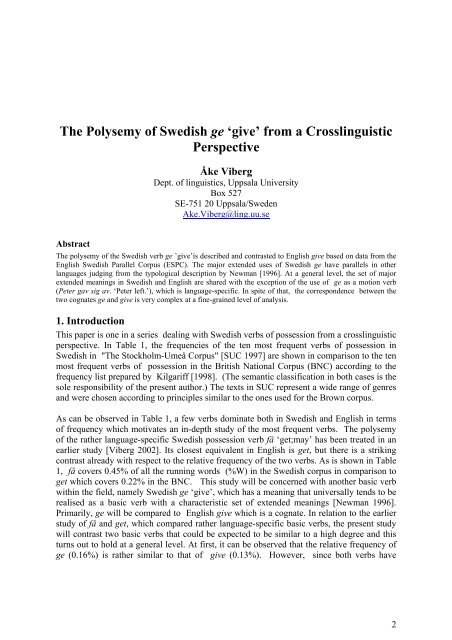The polysemy of Swedish ge 'give'
The polysemy of Swedish ge 'give'
The polysemy of Swedish ge 'give'
You also want an ePaper? Increase the reach of your titles
YUMPU automatically turns print PDFs into web optimized ePapers that Google loves.
<strong>The</strong> Polysemy <strong>of</strong> <strong>Swedish</strong> <strong>ge</strong> ‘give’ from a Crosslinguistic<br />
Perspective<br />
Åke Viberg<br />
Dept. <strong>of</strong> linguistics, Uppsala University<br />
Box 527<br />
SE-751 20 Uppsala/Sweden<br />
Ake.Viberg@ling.uu.se<br />
Abstract<br />
<strong>The</strong> <strong>polysemy</strong> <strong>of</strong> the <strong>Swedish</strong> verb <strong>ge</strong> ’give’is described and contrasted to English give based on data from the<br />
English <strong>Swedish</strong> Parallel Corpus (ESPC). <strong>The</strong> major extended uses <strong>of</strong> <strong>Swedish</strong> <strong>ge</strong> have parallels in other<br />
langua<strong>ge</strong>s judging from the typological description by Newman [1996]. At a <strong>ge</strong>neral level, the set <strong>of</strong> major<br />
extended meanings in <strong>Swedish</strong> and English are shared with the exception <strong>of</strong> the use <strong>of</strong> <strong>ge</strong> as a motion verb<br />
(Peter gav sig av. ‘Peter left.’), which is langua<strong>ge</strong>-specific. In spite <strong>of</strong> that, the correspondence between the<br />
two cognates <strong>ge</strong> and give is very complex at a fine-grained level <strong>of</strong> analysis.<br />
1. Introduction<br />
This paper is one in a series dealing with <strong>Swedish</strong> verbs <strong>of</strong> possession from a crosslinguistic<br />
perspective. In Table 1, the frequencies <strong>of</strong> the ten most frequent verbs <strong>of</strong> possession in<br />
<strong>Swedish</strong> in "<strong>The</strong> Stockholm-Umeå Corpus" [SUC 1997] are shown in comparison to the ten<br />
most frequent verbs <strong>of</strong> possession in the British National Corpus (BNC) according to the<br />
frequency list prepared by Kilgariff [1998]. (<strong>The</strong> semantic classification in both cases is the<br />
sole responsibility <strong>of</strong> the present author.) <strong>The</strong> texts in SUC represent a wide ran<strong>ge</strong> <strong>of</strong> <strong>ge</strong>nres<br />
and were chosen according to principles similar to the ones used for the Brown corpus.<br />
As can be observed in Table 1, a few verbs dominate both in <strong>Swedish</strong> and English in terms<br />
<strong>of</strong> frequency which motivates an in-depth study <strong>of</strong> the most frequent verbs. <strong>The</strong> <strong>polysemy</strong><br />
<strong>of</strong> the rather langua<strong>ge</strong>-specific <strong>Swedish</strong> possession verb få ‘<strong>ge</strong>t;may’ has been treated in an<br />
earlier study [Viberg 2002]. Its closest equivalent in English is <strong>ge</strong>t, but there is a striking<br />
contrast already with respect to the relative frequency <strong>of</strong> the two verbs. As is shown in Table<br />
1, få covers 0.45% <strong>of</strong> all the running words (%W) in the <strong>Swedish</strong> corpus in comparison to<br />
<strong>ge</strong>t which covers 0.22% in the BNC. This study will be concerned with another basic verb<br />
within the field, namely <strong>Swedish</strong> <strong>ge</strong> ‘give’, which has a meaning that universally tends to be<br />
realised as a basic verb with a characteristic set <strong>of</strong> extended meanings [Newman 1996].<br />
Primarily, <strong>ge</strong> will be compared to English give which is a cognate. In relation to the earlier<br />
study <strong>of</strong> få and <strong>ge</strong>t, which compared rather langua<strong>ge</strong>-specific basic verbs, the present study<br />
will contrast two basic verbs that could be expected to be similar to a high degree and this<br />
turns out to hold at a <strong>ge</strong>neral level. At first, it can be observed that the relative frequency <strong>of</strong><br />
<strong>ge</strong> (0.16%) is rather similar to that <strong>of</strong> give (0.13%). However, since both verbs have<br />
2
















